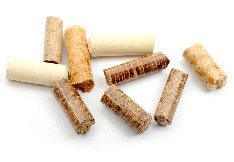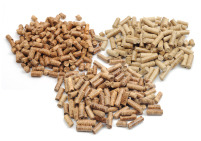
What Are Pellets?
So, what exactly are wood pellets? They are small dowels of solid fuel made of wood, about 1–2 cm in length. The raw material comes from timber thinned from forests, a necessary management technique to keep forests healthy, as well as from unusable wood scraps and sawdust.
Essentially, no trees are felled specifically for fuel. Only raw materials that have no other use are being repurposed and converted into a fuel source.
Because the pellets are formed through compression, they contain no adhesives or other chemicals.
Lignin, the epoxy-like substance in trees, is plasticized by compression and serves as a natural adhesive.
Wood pellets are a new, safe and reliable energy source derived entirely from nature.
There is great power in these tiny pellets.
Essentially, no trees are felled specifically for fuel. Only raw materials that have no other use are being repurposed and converted into a fuel source.
Because the pellets are formed through compression, they contain no adhesives or other chemicals.
Lignin, the epoxy-like substance in trees, is plasticized by compression and serves as a natural adhesive.
Wood pellets are a new, safe and reliable energy source derived entirely from nature.
There is great power in these tiny pellets.


In the West in the early 1970s and 1980s, sparked by two
fuel crises, wood pellets drew attention as an alternative fuel
source to petroleum. As the price of oil dropped thereafter,
wood pellets dropped out of the picture for a while, but in the 1990s, the environment-friendly image of wood pellets led to a rapid expansion of the wood pellet fuel market. Pellets have always been affected by competition with other fuels in terms of price, but demand has been growing steadily due to the ecological benefits, high quality, and ease of handling.
In Japan as well, starting in the 2000s, the number of pellet manufacturing sites began rising together with production volumes year by year. There has been rising interest in natural forms of energy especially since the March 2011 nuclear accident resulting from the Great East Japan Earthquake and Tsunami.


- Mixed:
- The bark and woody part are not separated. All parts of the tree are used. The resulting pellet color is speckled brown and white.
- White:
- The bark is peeled off and only the woody part of the tree is used. As the name indicates, these pellets are whiter than other types.
- Bark:
- Pellets are made from only the bark, giving them a deep brown color.

